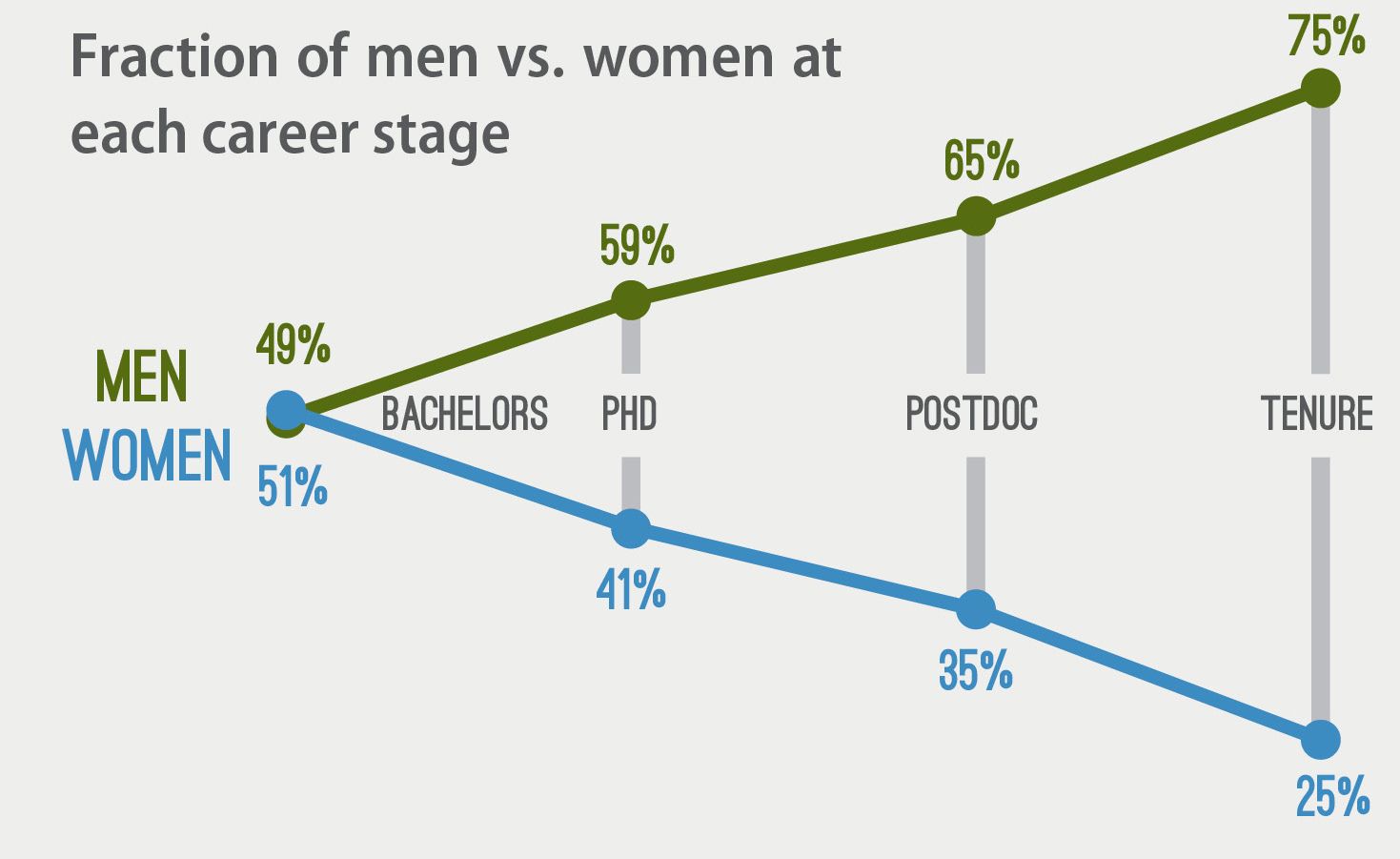
In 1870, one year after the original Oakland campus opened, UC Berkeley welcomed its first female students, establishing a then-progressive academic culture to be shared by scholars of all sexes. Despite admitting women, more than 100 years passed before the science and engineering departments granted tenure to one: Dr. Susan Graham, visionary computer scientist and engineer. It would take another ten years for a second woman to earn tenure in engineering and twenty in computer science. Other science departments fared no better. Today, Berkeley’s list of science and engineering full professors totals 96, 18 percent of full professors in these fields.
 Women continue to be underrepresented as they climb the career ladder, despite earning half of all bachelor’s degrees in science and engineering. Many universities, including UC Berkeley, are taking greater initiative to correct this imbalance.
Women continue to be underrepresented as they climb the career ladder, despite earning half of all bachelor’s degrees in science and engineering. Many universities, including UC Berkeley, are taking greater initiative to correct this imbalance.
Though the number of doctoral recipients in many science fields is fast approaching parity, it is no secret that universities struggle to attract and retain female faculty. “What we have found quite definitively is that women are leaking out of the academic pipeline in huge numbers,” says Dr. Mary Ann Mason, Berkeley law professor. To better understand this phenomenon, Mason turned to the National Science Foundation’s Survey of Doctoral Recipients, a database that tracks the demographics and career histories of doctoral recipients over their lifetimes. “Our research found that the rigidity of the tenure track and the lack of sufficient family-friendly policies at universities has steered many women away from academia,” she explains. This architecture disproportionately affects women. Female faculty delay family formation compared to their male counterparts and only single, childless women maintain competitive odds for earning tenure.
Changing this climate is vital to retaining talented scientists. Berkeley has long been a forerunner in tackling these challenges. Since 1988, six weeks of paid parental leave, tenure clock extension, and modified teaching requirements for faculty with young children have been available. Mason’s work led to the creation of the UC Faculty Family Friendly Edge program (UC FFFE) in the early 2000s. Funded by the Alfred P. Sloan Foundation, this project is dedicated to continuing research on the state of women in academia and developing better policies within the UC system to address difficulties in achieving work-family balance. UC FFFE research recently resulted in several new initiatives, including a flexible part-time tenure track option.
These policies have benefited everyone. Campus-wide, the number of female faculty has doubled. Twice as many babies were born to assistant professors in 2009 as in 2003. Moreover, while only 6 percent of new fathers at UC Berkeley took teaching relief in 2003, this percentage has increased by an order of magnitude.
However, women continue to remain largely underrepresented among full professors. Data from UC FFFE reveals that women frequently did not take advantage of family-friendly policies for fear of stigma and professional repercussions. “Research has demonstrated that implicit bias against women is very much a part of academia. In particular, the pregnancy bias; the idea that women who have children won’t be as productive,” says Mason. Furthermore, due to Proposition 209, a candidate’s sex (or ethnicity) may not be considered in faculty appointments, where this bias has been demonstrated to negatively affect female candidates.
Further agitating matters is the lack of child-care services for doctoral students and postdoctoratal researchers, the two highest contributors to the leaky pipeline. “Graduate school is decidedly not family friendly,” says PhD candidate Anna Vlasits. “My husband and I barely make enough to pay for childcare but make just enough not to qualify for subsidized on-campus childcare.” Services at UC Berkeley are extremely limited; a total of 250 childcare spots are available each year. Doctoral student enrollment totals nearly 6,000. “It is incredibly important to have affordable childcare for postdoctorates and students on campus,” says Dr. Marla Feller, a neurobiology professor and mother. “I see students looking at their peers with children who are struggling and seriously contemplating if the university is willing to support them. It’s maddening to think that we are losing talented women because of this when increasing childcare availability is such an obvious solution.”
In response to the need for continued structural changes, the university has developed several new action items. Adoption benefits, mandates for family-friendly scheduling, and increased accessibility to affordable child care are currently in progress. UC FFFE also strongly supports re-entry postdoctoratal opportunities for those looking to return to academia following family-related work gaps. These initiatives have been structured around faculty survey data, where they received wide support; however, they have yet to be implemented. Nonetheless, by continuing to push for innovative policies that help faculty and students pursue better work-life balance, UC Berkeley can continue to maintain a competitive edge by attracting the best and brightest.
This article is part of the Spring 2014 issue.



